Date: 26 November 2025
Time: 16:00-19:00
Location: Humboldt University Berlin
Organisation: Humboldt University Berlin, Network Colonial Collections
Language: German/English
On 26 November 2025, the Network Colonial Contexts of the Humboldt University in Berlin is celebrating its 5th anniversary. To mark this occasion, they invite those interested to an in-person event in Berlin for the first time. During the event, they will look back on the events of the last few years and take a look into the future.
The programma includes a guided tour through the photo collection of the art library and a roundtable discussion with Sarah Fründt (German Lost Art Foundation), Andrea Scholz (Staatliche Museen zu Berlin) and Richard Kuba (Frobenius Institute for Research in Cultural Anthropology), followed by drinks and dinner.
Final Conference Pressing Matter | Rethinking the Restitutionary Moment: What Next?Date: 27-28 November, 2025
Time: 09:00 – 17:00
Location: Wereldmuseum Leiden
Organisation: Pressing Matter, Wereldmuseum, Vrije Universiteit Amsterdam, Research Center for Material Culture
Language: English
The multi-year research project Pressing Matter: Ownership, Value and the Question of Colonial Heritage in Museums draws to a close at the end of 2025. Pressing Matter, funded by the Dutch Science Agenda (NWA-NWO) and the consortium partners, investigated the future of objects collected in colonial times. It asked about the potentialities of ‘colonial objects’ to support societal reconciliation with the colonial past and its afterlives, and how best to deal with conflicting claims by different stakeholders for these objects.
This final confernce explores what Pressing Matter’s critical friend, Professor Ciraj Rassool, has described as the restitutionary moment we now inhabit. The conference is conceived of as a series of provocations from distinguished international scholars who have been involved, both both theoretically and practically, in the discussions around the question of what to do with the objects collected during the colonial period that now reside in European Museums. Each presenter is asked to respond to the question ‘what now, what next?’. These presentations will be followed by extended conversations with the different researchers from the Pressing Matter project about their initial aims at the beginning of the project, what we have done, and how these aims may have been revised over the period of the project. Importantly, the conference explores what further work must be done to achieve the kinds of changes that Pressing Matter had imagined at the start of the project: to explore how we might conceive of restitution beyond its programmatic and policy limitations, but also to address the questions that this restitutionary moment raises in national and international contexts about living within the afterlives of colonialism.
Achille Mbembe: A Future of Solidarity
The two-day conference is preceded by a Brainwash Special with Achille Mbembe at the Wereldmuseum Amsterdam on Wednesday 26 November 2025, from 19:00-22:00. In this Brainwash Special, Wayne Modest, Director of Content at Wereldmuseum Amsterdam, will be in conversation with Achille Mbembe to discuss the fractures that define our societies today. How do we hold on to solidarity in a world that seems to divide rather than connect? And what might a future look like in which everyone truly matters?
Seminar Moving objects, mobilising culture in the context of (de)colonizationDate: Tuesday 18 November
Time: 15:00-16:30 (CET)
Location: KITLV, Herta Mohr building, room 1.30 (Witte Singel 27A, Leiden) and online via Zoom
Organisation: KITLV/Royal Netherlands Institute of Southeast Asian and Caribbean Studies
Language: English
During this seminar, the 2025-2026 NIAS-NIOD-KITLV fellows of the Fellowship Moving Objects, Mobilising Culture, will present on their research. The program includes presentations by Panggah Ardiyansyah, Leandro Mathews Cascon and Ganga Dissanayaka.
The Moving Objects, Mobilising Culture Fellowship enables researchers and heritage practitioners from formerly colonized countries to access and conduct research on (collections of) objects – whether defined as cultural, historical, ancestral, art or otherwise – which are currently (lost) in the Netherlands, as well as on related archives and documentation. This fellowship is funded by the Colonial Collections Consortium.
The fellows are invited to actively use, reflect on and engage with these collections, but are also encouraged to explore and (re-)establish connections with related communities, collections and sites in the country of origin or other countries. Fellows are encouraged to follow queries regarding the social histories and valuation of objects, in relation to or beyond questions of restitution, and to seek for the signification of objects and their trajectories in space and time, beyond the framings of heritage institutions or national histories.
HERE: Heritage Reflections 2025Date: Monday 10 November
Time: 14:00 – 17:30
Location: Wereldmuseum Amsterdam
Organisation: Mondriaan Fonds and the Wereldmuseum Amsterdam
Language: English
On 10 November 2025, the Wereldmuseum Amsterdam, and the Mondriaan Fonds are organizing a new edition of HERE: Heritage Reflections 2025. HERE is a seminar for both new and experienced heritage professionals, bringing them together to stimulate knowledge exchange and innovation. This edition focuses on the theme restitution.
The program includes a plenary discussion, workshops and guided tours. During a workshop on provenance research, speakers from the Colonial Collections Consortium will guide participants through the Colonial Collections Datahub and share insights into the platform’s latest developments.
Provenance research blog #3
In the blog series of the Colonial Collections Consortium, we present a historical object from a former colonial context or situation, currently stored in a museum in the Netherlands that has been the focus of provenance research. With this blog, we want to give an insight of the importance of provenance research and show the different ways of approaching this type of research. Therefore, each blog explains the steps taken by the respective museum or provenance researcher to carry out the research. Which stories lie behind the object and what can they tell us about the Dutch colonial past?
In focus this time: a beaded headdress from Mozambique in the collection of Wereldmuseum Rotterdam.
An “invisible empire”: brief historical background
Cultural objects in Western museums which were collected or looted in a colonial context contain many – sometimes little-known – stories about this period. Provenance research is a valuable tool that helps bring these stories to light. However, it can’t provide all the answers and often raises new questions. Making knowledge about collections available is important, as it allows for a better understanding of museum collections and makes it possible for countries and communities of origin to locate their cultural heritage.
This is particularly relevant when dealing with collections that one might not expect to find in Dutch museums, such as the many objects from the African continent. The beaded headdress looted in Mozambique in 1884 and addressed in this blog is a good example. By the late nineteenth century, the Netherlands no longer possessed colonies in Africa, yet it still participated in and profited from European exploitation of African labour and natural resources. At this time there were hundreds of Dutch trading posts across the continent, around 10 of which were in Mozambique, then a Portuguese colony. Provenance researcher François Janse van Rensburg refers to this as an “invisible empire” of Dutch trade in Africa.
Today, the Wereldmuseum contains thousands of objects from Africa, sent to the Netherlands by employees of Dutch trading companies, such as the Nieuwe Afrikaansche Handels-Vennootschap (NAHV), the Oost-Afrikaansche Compagnie (OAC), and Hendrik Muller & Co. Many of these objects – including the headdress – were brought by the directors and employees of these companies. One such collector was Hendrik Muller (1859-1941). The Muller family was deeply involved in commercial activities in Central and Southern Africa, including these companies. Hendrik Muller also participated in the Berlin conference in 1884-1885, where the African continent was divided amongst European powers. Alongside trade, Muller’s father was one of the co-founders of the Wereldmuseum Rotterdam. Muller himself, during his time as co-director of the OAC, became interested in anthropology during a visit to Mozambique where he acquired many objects for the museum.
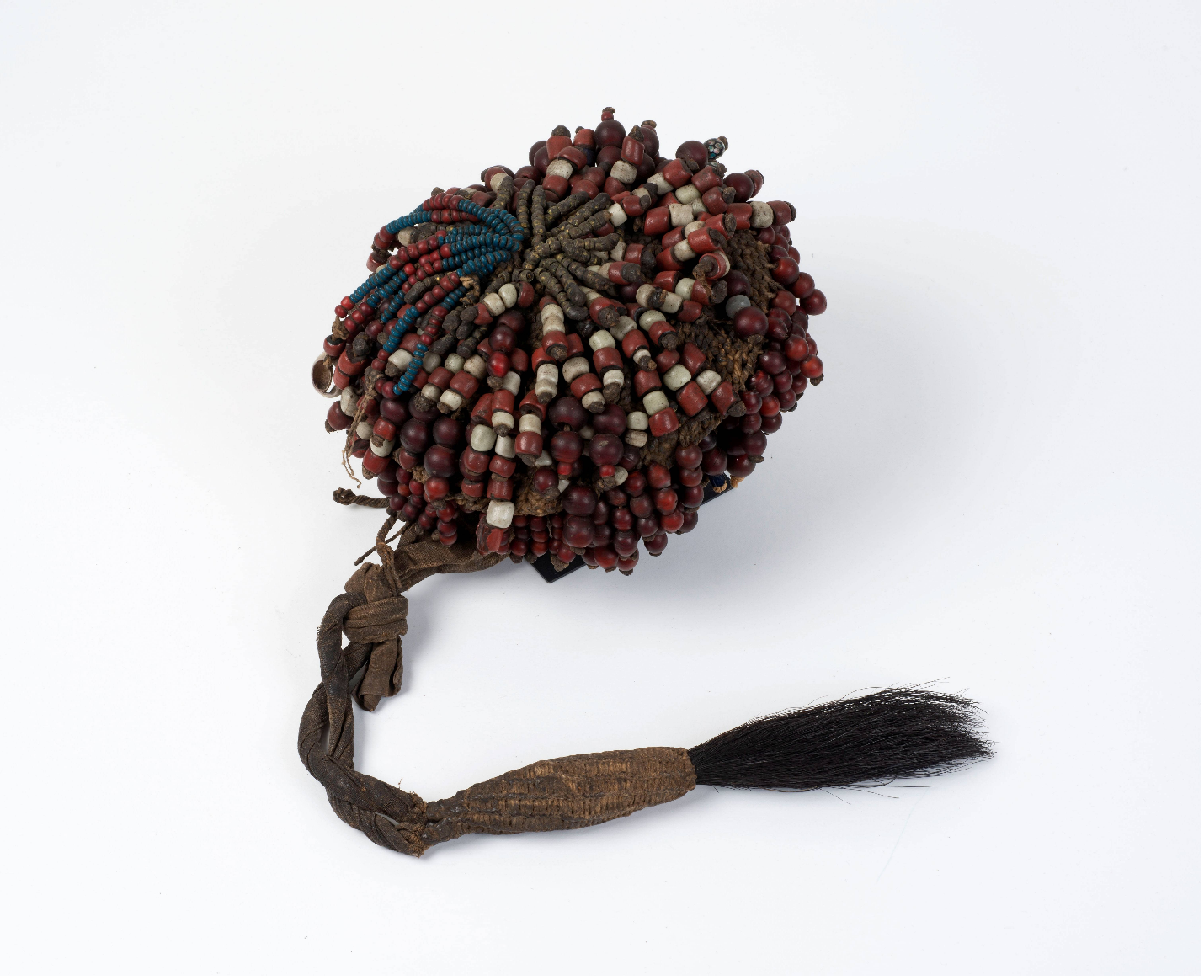
The provenance research
Provenance research is sometimes carried out in the context of requests for restitution, as shown in blog #2. In other cases, such as the flag in blog #1 or the Mozambican headdress, it is driven by research questions. The research presented here and carried out by Janse van Rensburg started with a book, ‘Industrie…du sud-est de l’Afrique’. Written at the end of the nineteenth century by Hendrik Muller and anthropologist Johannes Snelleman, it contains ethnographic descriptions mainly of Mozambique and features illustrations of objects, including the headdress. It describes the headdress and the materials it is made of (such as cotton, beads, cowries, the tail of a wild animal). A footnote clarifies that it would have been worn by a Massingire priest and that it was taken during a war. Janse van Rensburg aimed to understand what the Dutch were doing in Mozambique at the time and how this object ended up in the Netherlands.
The research followed the usual steps. First, consulting the information available in the museum. This included the inventory card, which indicated that it was donated in 1885 by M.H. Maas, a Dutch consul in Quelimane in Mozambique, and employee of the OAC. Janse van Rensburg searched the museum’s archive and found a letter that was connected to this donation. Written by Hendrik Muller and addressed to the then director of the recently founded Museum for Land and Ethnology in Rotterdam (later Wereldmuseum), the letter claimed that it had been worn by a spiritual leader during a ritual that preceded a revolt of the Massingire people in 1884 in the Zambezi River region in Mozambique.
The Massingire War of 1884 was one of the first anti-colonial rebellions against Portuguese colonialism in Mozambique. It took place in the context of intensifying colonialism by European powers around the time of the Berlin conference. This intensification involved annexation of territory, exploitative taxes, and a ban on Massingire religious practices leading to the 1884 revolt. The revolt soon turned into a general uprising, with rebels targeting Dutch, French, and Portuguese commercial enterprises (such as trading posts and opium plantations) which made their incomes through exploiting the local peoples.
While many items acquired by Muller and other collectors were bought from local populations in what today would be seen as tourist markets, others were obtained through theft and looting. Considering the archival materials available, it was possible to conclude that it was most likely looted in the context of this conflict.
Reflection: an unfinished process
Because all archival sources used for the research were European, many questions remain to be answered: who were the Massingire? Who wore the headdress and for what purpose? Might the headdress still hold meaning for people today? What does this looted object say about other objects which were not looted, but collected in the same context of colonial exploitation (such as this tablecloth from Mozambique)? This reveals the limits of archival-based research. To answer these questions, more time and (financial) resources would be required to seek collaborations with researchers in Mozambique and carry out fieldwork. With so many objects to be studied, provenance researchers often need to limit their focus to understanding how an object was appropriated and ended up in the museum.
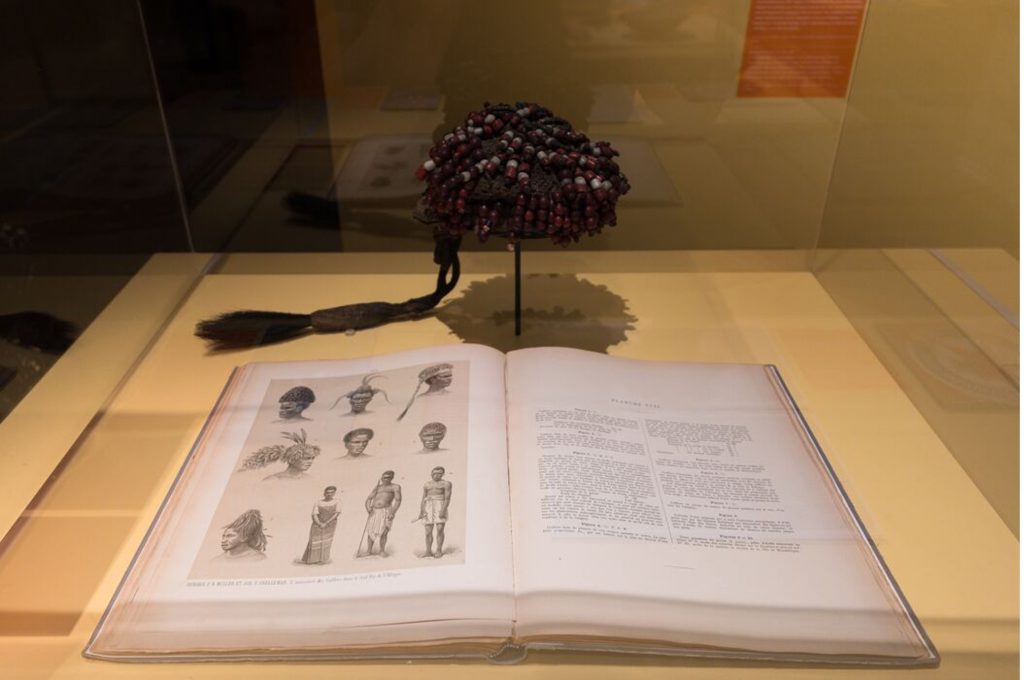
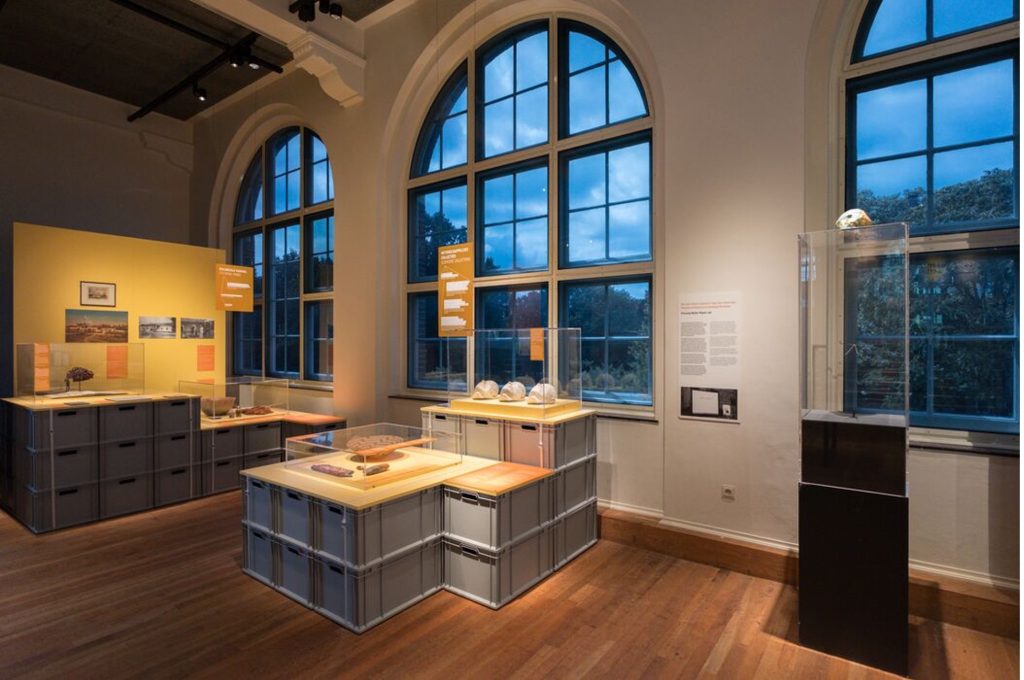
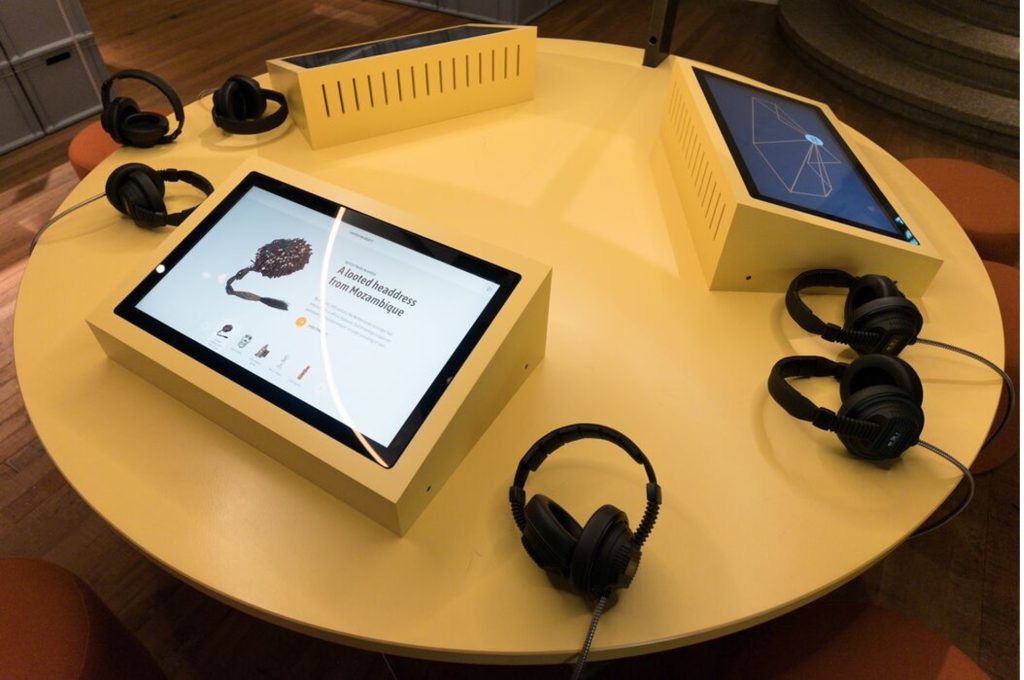
For this reason, provenance research can often be seen as an unfinished process. Hence it is important to make the existing knowledge publicly available, for instance, through publications, presentations or exhibitions. The research carried out by Janse van Rensburg has been published and is currently shown in the exhibition “Unfinished past: return, keep, or…?” at Wereldmuseum Amsterdam, which is part of the Pressing Matter project. This exhibition dives into the current debate on restitution and critically explores the ways in which objects from colonial contexts entered the collections of European museums (and this one in particular), including through trade, scientific expeditions, diplomatic gifts, missionary work or colonial conquest.
The headdress is used there as an example of an object acquired through Dutch colonial trade, as well as to show the connections between trade and conflict. Furthermore, the results of the provenance research are presented on a touchscreen, amongst other provenance histories. Through photographs, letters and other archival materials consulted for the research, the headdress sheds light on the histories of the Dutch “invisible empire” in Africa.
The exhibition also raises questions about possible next steps – what to do with an object that is known to be looted, yet where knowledge – and potential interests – of the community of origin are missing? Hopefully sharing this knowledge will lead others to pick up where this research ended, to dig deeper into the histories and meanings contained in this and many other cultural objects and belongings in Dutch museums.
Final words
To better understand the historic and current meanings of objects, and how to ethically care for them, information about their origin and acquisition histories are essential. Provenance research is an ongoing process for museums. The Colonial Collections Consortium supports institutions that manage collections with this work by sharing knowledge and information, and by offering stakeholders a network. Would you like to know more or share information with us? Please contact us!
References and further reading
The provenance research presented here was carried out by François Janse van Rensburg of Wereldmuseum in the context of the Pressing Matter project. This research is currently presented in the exhibition Unfinished Pasts at Wereldmuseum Amsterdam and was published in REALMag #10 (2025). A more in-depth article about the headdress and its provenance will soon be published in an upcoming publication of Pressing Matter.
Date: Wednesday 1 October
Time: 10:00 – 17:00
Location: Rijksdienst voor het Cultureel Erfgoed, Smallepad 5, Amersfoort
Organisation: Rijksdienst voor het Cultureel Erfgoed en Nederlandse Kastelenstichting
Voertaal: Dutch
The Cultural Heritage Agency of the Netherlands (RCE) and the Dutch Foundation for Castles (NKS) are organising a meeting on the shared past and joint future of castles and country houses. Together with experts, and the audience, they explore and discuss the heritage of castles and country houses, as part of the colonial past and the past of slavery. This meeting takes place on 1 October, 2025.
During the meeting, the presence and (in)visibility of traces of the slavery past are discussed, through practical case studies and recent research counducted at country estates. Additionally, the Colonial Collections Datahub is presented as a new digital research tool. The program allows space for different perspectives on the continuation of the colonial and the slavery past, and furthermore includes performances, spoken word and poetry.
SAHRA Heritage Month 2025: International Virtual SeminarDate: Thursday 18 September 2025
Time: 09:00 – 17:00
Location: Online
Organisation: South African Heritage Resources Agency
Language: English
As part of the SAHRA Heritage Month 2025, the South African Heritage Resources Agency is hosting a series of virtual seminars. This year’s webinar, under the theme ‘Resilient Heritage: Safeguarding South Africa’s Legacy in a Changing Climate,’ takes place over four days in a fully virtual format. The program aligns with broader G20 theme of Climate Change and Resilience, reflecting the commitment to engaging with global conversations on sustainability, climate adaptation, and cultural preservation.
On 18 September, the SAHRA will in particular focus on colonial collections and restitution, during the webinar ‘Restitution of Cultural Property’, bringing together global voices to explore pathways for return, protection, and circulation of cultural heritage. This dialogue will reflect on international best practices, highlight Africa’s experiences in restitution, and consider how G20 collaboration can strengthen policy, diplomacy, and ethical stewardship to include voluntary disclosures by the host/holding countries. By engaging experts, governments, and heritage practitioners, the webinar seeks to advance a shared commitment to justice, reconciliation, and sustainable cultural heritage management.
The full programme of this virtual seminar is available below.
Grant awarded to eleven museums for provenance research into colonial collections10 September 2025
The Provenance Research Scheme by the Colonial Collections Consortium contributes to eleven museums that will investigate the provenance history of their (sub)collection or a specific object for which there are indications that it was acquired in a colonial context. The Provenance Research Scheme made a total of €500.000 available for such research. In this second round of applications, €256.683 has been awarded. The second round was the last round for the Provenance Research Scheme.
Awarded projects
Read more about the awarded projects of the second round below.
Beeld en Geluid (€24.000)
Beeld en Geluid is conducting research into three Sticusa-films (Stichting Culturele Samenwerking Suriname en de Nederlandse Antillen/Foundation for Cultural Cooperation) from the 70s, to indicate their provenance and context. The films will be returned to the people in Suriname and the Antilles, and will be made available for education, so they can serve as a tool for reflection and dialogue about (post)colonial relations.
Universiteit Leiden (€10.000)
Prof. dr. Ben Arps (Leiden University) conducts provenance research into eleven unique maps from Java, from 1825. They depict the districts of the regency of Semarang and are currently part of the collection of the National Archives. Their creators, purpose, and journey to Europe are unknown. Analysis of style, language, and context should reveal their provenance and shed new light on their colonial heritage.
Universiteitsmuseum Groningen (€13.749)
The Universiteitsmuseum Groningen conducts provenance research into the sub-collections of Gerardus van der Leeuw, in particular, religious and ritual objects from missionary and colonial networks. The project focuses on unknown provenance, ethical acquisition, and the context of collections, in addition to digital access and publication of the findings to science and the public.
Boijmans van Beuningen (€30.000)
Boijmans van Beuningen conducts provenance research into the sub-collection of Dr. Johan C.J. Bierens de Haan (1883-1958), the objects were collected from Tibet, China, Iran and Japan (1909-1920). The research focuses on the context of collection, the political situation of the region and the possibly problematic provenance of the objects.
Rijksmuseum Boerhaave (€27.360)
Rijksmuseum Boerhaave researches the sub-collection of Jan van der Hoeven (1801-1868), in which his scientific work and colonial context are visible. The research focuses on the provenance of zoological and physical-anthropological collections, including objects and portraits, and explores how the Dutch colonial expansion shaped his scientific activities.
De Mesdag Collectie (van Gogh Museum) (€23.980)
This project conducts research into circa 80 Indonesian objects that are suspected to have been acquired from a colonial context, such as temple and ancestral statues, weapons, and architectural fragments. The goal is to trace their provenance, reconstruct the context of removal, and identify possible restitution claims, using experts and specialist provenance research.
Keramiekmuseum het Princessehof (€30.000)
This project conducts research into circa 80 Indonesian objects that are suspected to have been acquired from a colonial context, such as temple and ancestral statues, weapons, and architectural fragments. The goal is to trace their provenance, reconstruct the context of removal, and identify possible restitution claims, using experts and specialist provenance research.
Zaans Museum (€18.170)
The Zaans Museum conducts research into eighteenth- and nineteenth-century clothing made out of chintz to establish the colonial provenance of the fabrics. By making a distinction between Indian and European chintz, insights are given into production, trade routes of the VOC and the role of these clothes in the Zaan identity.
Museum Catharijneconvent (€20.000)
Museum Catharijneconvent researches the colonial context of mission objects. The project studies inculturation, colonial provenance of materials, and ownership, with attention to local creators and power relations. This is intended to give insight into cultural exchange, religious influence, and the connections between Christianity and European colonialism.
Allard Pierson (€29.986)
Het Allard Pierson researches the Houbolt-collection. These objects were collected from Indonesia, New Guinea, and Malaysia. The project explores in what ways the objects were collected, by whom, and under which circumstances. Additionally, the project explores whether the objects present a case of involuntary loss, in collaboration with the Universitas Gadjah Mada.
Missiemuseum Steyl (€29.436)
Missiemuseum Steyl conducts research into objects of the collection of the Mission Sisters of the Servants of the Holy Spirit. This research focuses on a Japanese Buddhist household shrine. By tracing the provenance, the project aims to give insights into the connection between imperialism, missionary work, and colonialism and to contribute to the decolonization discussions outside of museum and national collections.

Provenance research blog #2
In the blog series of the Colonial Collections Consortium, we present a historical object from a former colonial context or situation, currently stored in a museum in the Netherlands that has been the focus of provenance research. With this blog, we want to give an insight of the importance of provenance research and show the different ways of approaching this type of research. Therefore, each blog explains the steps taken by the respective museum or provenance researcher to carry out the research. Which stories lie behind the object and what can they tell us about the Dutch colonial past?
In focus this time: seven Tigua sacred ‘objects’ of the Ysleta del Sur Pueblo community, United States.
Brief historical background
The Ysleta del Sur Pueblo (or YDSP) is a federally recognized Native American tribe in El Paso, Texas. The Tigua people (pronounced Tiwa) of YDSP were deeply impacted by Spanish and later US colonialism. In 1680, following a revolt against Spanish rule, they were forcibly relocated from New Mexico to Texas. In the nineteenth century, they, like many other Native American tribes, were driven to extreme poverty due to the appropriation of their land and resources by both the US and state governments. It was in this context of duress that the objects were bought in 1882 by the Dutch anthropologist Herman Frederik Carel Ten Kate jr., during an expedition to study Native Americans. This acquisition was done at the request of Lindor Serrurier, the then director of the National Ethnographic Museum (a precursor of Wereldmuseum Leiden), using Dutch government funding.
In 2024, the YDSP Pueblo, with the support of the US government, submitted a restitution request to the Dutch government. In question were five (and ultimately seven) objects managed by Wereldmuseum Leiden. This request argued that since these are ceremonial and spiritually important representations of the culture and faith of the Pueblo, they should be returned. Following this request, Wereldmuseum carried out provenance research about the objects, leading to the conclusion that their transfer to the Netherlands and this museum in 1883 represented a case of involuntary loss.
About the Tigua ceremonial ‘objects’
The seven objects – the fragment of a headdress, two drums and respective drumsticks, three rattles, a shield, and moccasins – constitute sacred, communally owned belongings of the Tigua people of YDSP. Of particular importance are the double-headed drum and drumstick, which is believed to be the twin of the Pueblo’s remaining ceremonial drum. According to tradition, both were made from the same tree 350 years ago in New Mexico, before the Tigua’s exile to El Paso. The restitution claim of 2024 noted the drum’s importance to the ceremonial cycle and its connection to the Winter clan (now the Pumpkin and Corn villages), while the remaining drum belonged to the Summer clan. Without the Winter clan’s drum, the Summer clan’s drum is used for both summer and winter dances.
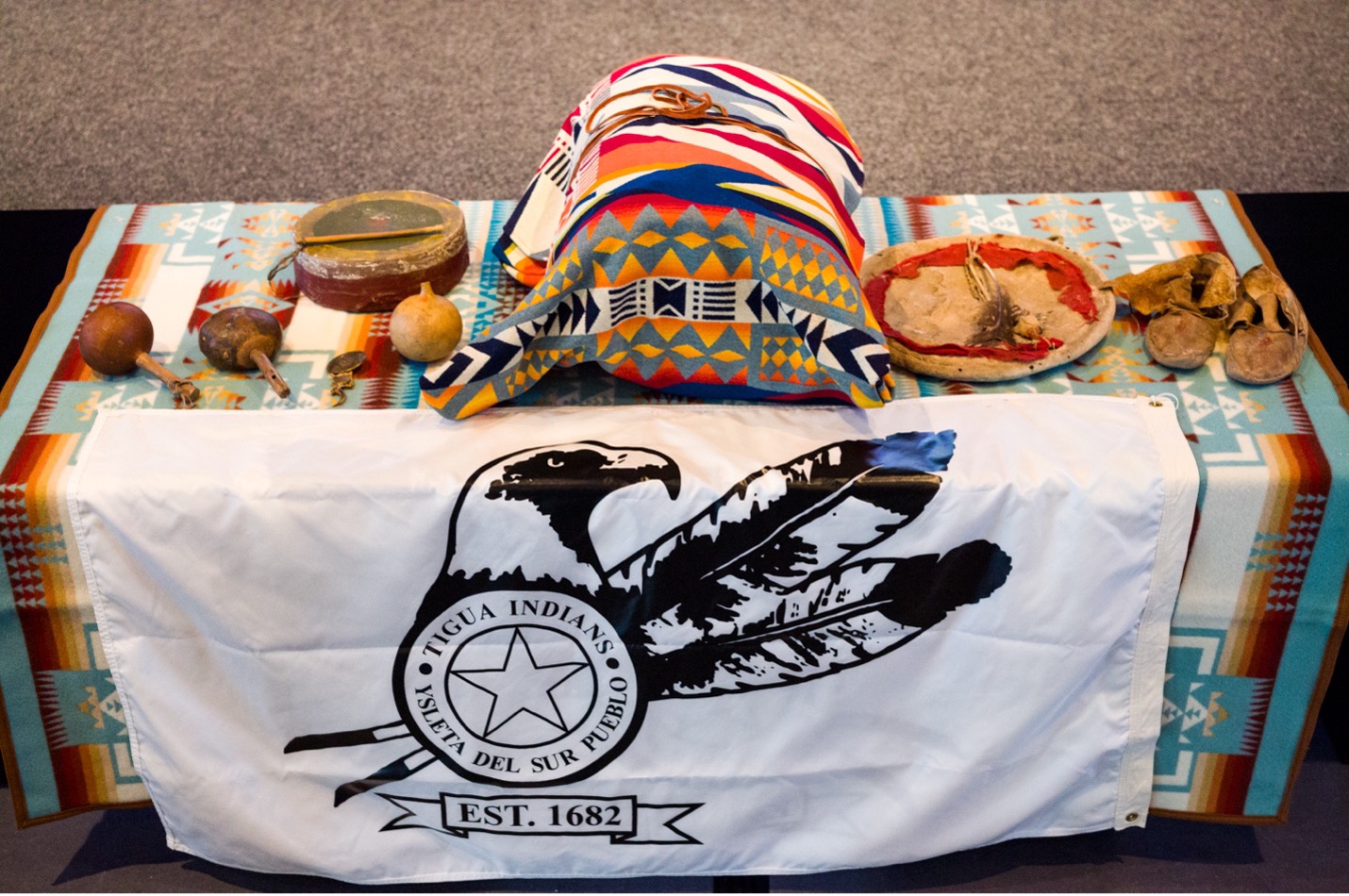
The current “restitutionary conjuncture”
The Tigua’s first official request for repatriation was made by the Tribal Council of Ysleta del Sur Pueblo in 2014, although the Tribal Council claims there were earlier requests, dating back to 1967. This request was rejected by Wereldmuseum on the basis that the objects had been legally sold. While several meetings and negotiations between the Tribal Council and the museum followed this decision, effective change only took place in 2024.
In recent years, important steps have been taken in the Netherlands and beyond towards the development of restitution policies, making it possible to speak of the current moment as a “restitutionary conjuncture”, to quote provenance researcher Klaas Stutje (2025). More specifically, in 2021, the Dutch government published its policy vision on collections from a colonial context, followed in 2022 by a Letter to Parliament on its implementation. Since then, a few hundred historical objects have been returned, mainly to Indonesia and Sri Lanka.
The provenance research
Following the 2024 restitution request, the Wereldmuseum conducted provenance research on the Tigua’s sacred artefacts. The research and resulting report focused on 1) the history of the YDSP to better understand the context during which the objects had been collected; 2) Ten Kate’s expedition to North America in 1882-83, to understand the role played by the Dutch government and museum in this expedition, as well as the anthropologist’s collecting practices; 3) Ten Kate’s visit to YDSP and the seven objects; and 4) the history of the relationship between Wereldmuseum and Pueblo.
The first point was answered mainly using secondary resources. The second and third points involved analysing the correspondence related to the financing by the Dutch government of the purchase of objects by Ten Kate and his donation of those objects to the museum in 1883. The museum’s inventory cards and a travel report by Ten Kate included important information that detailed Ten Kate’s use of unethical acquisition methods, involving coercion, threats and bribery. His travel report mentioned the objects and suggested that the sale by War Captain Bernardo Holguin had not been entirely voluntary, since on the following day, Holguin expressed remorse about this sale and tried to reverse the transaction.
Information shared by representatives of YDSP in the context of recent dialogues with Wereldmuseum and the 2024 restitution claim also offered vital information about the acquisition context, leading to a more critical and context-sensitive understanding of the conditions in which the objects were taken. Of particular importance were the arguments that Holguin had been coerced by Ten Kate to sell the objects, that his willingness to sell sacred communal artefacts was due to the extreme poverty experienced in YDSP at the time, and that Holguin was in fact not authorized to sell these since he didn’t own then but rather managed them for the community. This information was central to the final decision regarding the restitution claim.
Reflection
The provenance research showed that the acquisition of the objects in 1882 was against the wishes of YDSP, even if it resulted from the sale of the items by a member of the community. Dialogue with the community in more recent years – and mainly in the context of the restitution requests – reiterated this fact and emphasized the ongoing importance of these objects to the Tigua’s ceremonies and rituals. This reexamination of the historical context in which the objects were acquired offers an important example of how complex it is to accurately assess the conditions and power (dis)balances in place when objects are collected or seized, without disregarding the agency of the original owners. Crucially, it shows that provenance research and a critical understanding of historical and cultural circumstances should, as much as possible, result from an open and reciprocal dialogue between museums and the communities of origin.
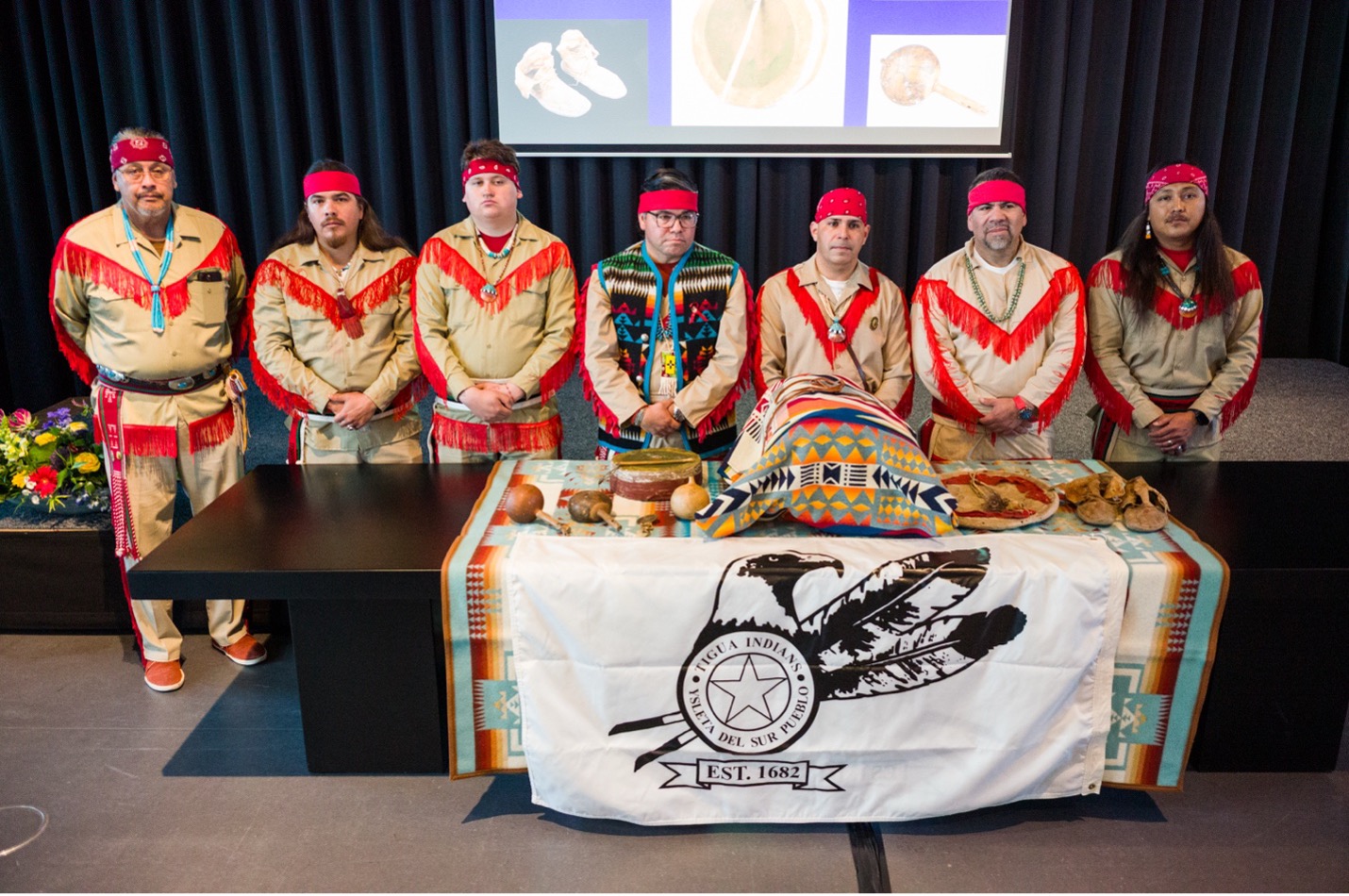
Final words
In response to the restitution request by the US and YDSP, and on the advice of the independent Colonial Collections Committee (in line with the Dutch Policy vision on collections from a colonial context), the Dutch Minister of Education, Culture and Science Eppo Bruins decided in early 2025 to return the seven objects unconditionally. A ceremony to mark this return took place on 20 March 2025 at Wereldmuseum Leiden (see photograph).
To better understand the historic and current meanings of objects, and how to ethically care for them, information about their origin and acquisition histories are essential. Provenance research is an ongoing process for museums. The Colonial Collections Consortium supports institutions that manage collections with this work by sharing knowledge and information, and by offering stakeholders a network. Would you like to know more or share information with us? Please contact us!
References and further reading
The provenance research presented here was carried out by provenance researcher François Janse van Rensburg (Wereldmuseum). The report and the advice of the independent Colonial Collections Committee can be found here. The information presented in this blog derives from this report, as well as email communication with François Janse van Rensburg. More information about the return of the seven objects can be found on the websites of the Dutch government and of Wereldmuseum. For more information about the Dutch policy for dealing with collections from a colonial context, please see the website of the Colonial Collections Consortium.
On 15 July 2025, the second round of applications for the ‘Regeling Herkomstonderzoek Koloniale Collecties,’ was closed. The assessment committee will gather shortly to assess all the received applications.
Members of the assessment committee:
- Mirjam Hoijtink, Head of Research & Collections, Wereldmuseum
- Karel Weener, provenance researcher, History Department, Rijksmuseum
- Klaas Stutje, senior researcher affiliated with the Expertise Center Restitution, NIOD Institute for War-, Holocaust- and Genocide Studies.
- Pauljac Verhoeven, director, Museum Bronbeek